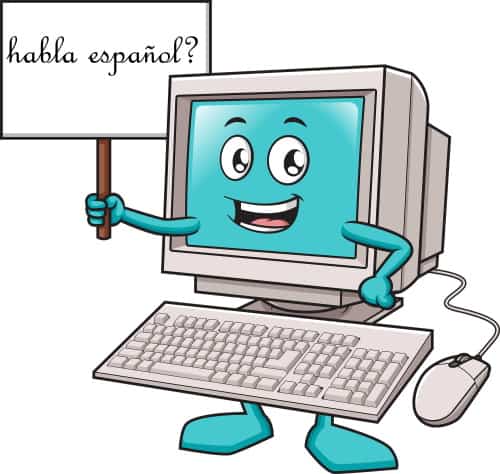
There are many cities in the US where Spanish is spoken more than English. Spanish has slowly become a more widely spoken language in the US and has made people wonder if Spanish will ever replace English as the US’s official language. Wait, is there an official language in the United States?
There is no real possibility that Spanish will replace English in the USA. This could only happen in practice anyway, as the United States has no official language. English is cultural; the language of science and math; and the most spoken language in the world, making replacement very unlikely.
With that said, could we become a bilingual society? Now, that is a real possibility. If you’re interested in how Spanish could potentially replace English as the most common language in the USA or at least become as widely spoken, read on. Let’s explore why Spanish is one of the world’s top languages and how it continues to grow in the United States. (I’ve also addressed if Spanish is fun to learn or not in another article.)
Contents
Reasons Why Spanish Is Widely Spoken in the USA
There are a few different reasons why Spanish is more widely spoken now than ever before, which is why the question of it replacing English is even plausible. Up next, we’ll detail why Spanish is spoken by so many and how it could potentially replace English in the USA, though unlikely as stated above. This discussion is actually eye opening for some. The position of Spanish and English in the U.S. is not as it first may seem.
Immigration
The United States has large amounts of people immigrating to the country every year, and many of these people are from Spanish-speaking countries. This automatically raises the number of Spanish speakers in the United States. Yet, it doesn’t necessarily mean that Spanish speakers will overtake English speakers. Let me explain further.
This actually has something to say about the rise of Spanish in the United States and its staying power. It is not because of the second and third generations of these families that Spanish is rising; but the immigrants themselves who speak it. In actuality, by the time their grandchildren are learning to talk, it is English that they will normally speak fluently. To state it clearly, Spanish is not normally spoken at any conversational level for them.
There is a common misconception about how Spanish is spoken in the U.S. It goes something like this…
An aspect of immigration that affects Spanish speakers’ number is the language being spoken in the home. People growing up in the home or around the home will help other people learn the language and become proficient. This also increases the number of people knowing the language in the country.
This is propagated by further assumptions such as…
In the same vein, school-aged children may be proficient in Spanish but require English Language Learner Services. These students may not become skilled in English enough to be considered English speakers.
On the contrary, it is the opposite effect.
As immigrants become more ingrained in the local culture, their offspring are more likely to assimilate and in this case, speak English. Research lists varying factors such as intermarriage and particular native countries that affect language loss, but most all agree that by third generation, English is the predominant language of immigrant families-unless specific and direct countermeasures are taken.
Essentially, the children and grandchildren of immigrants don’t see themselves as newcomers like their grandparents, nor do they have ties to the previous culture and language in the same way. Suffice it to say, it is rare for second and third generations from immigrants to be fluent in any other language than English. I saw this particularly affect my students from Spanish-speaking cultures.
My ELL students who’d lived in the US for several years at minimum were already apt to speak English more than their family’s native Spanish. This is completely normal as that is a common effect of immersion, or living in another country. However, it was especially common for those ELL students who were born in the US to barely speak Spanish-the language of their parents. It may surprise you that this was true even if their parents only spoke Spanish at home.
I’d have conferences with parents (and students) who’d have lived in the country for sometimes 10 or more years. Yet my students would say to me, “Mrs. Booe, my mom needs a translator.” Of course, I’d arrange this, but I wondered about the language barriers between my students and their parents because in most of these cases, my students were only able to speak a few Spanish phrases, and certainly couldn’t read or write in Spanish.
[Side note regarding ELL/ESL classes: Students are granted ELL/ESL services if they come from a home where a language other than English is spoken primarily. Thus, it’s quite common to have ELL/ESL students participate in English language services even though they speak only English because of their parents’ primary language.]
The parents would express frustration about this too, via the translators, with me when I brought it up because they really wanted their child to be bilingual and not lose the language of their culture. They recognized the benefits of speaking more than one language, as well as had the desire to pass down their cultural identity through language.
But that wasn’t happening for cultural immersion and political reasons, as well as desires expressed by the children themselves. And of course, this barrier was cemented by the fact that the parents were mostly monolingual. But like all parents, they wanted more for their children.
And now you can see how it’s not guaranteed that increased immigration of Spanish-speakers means a lasting rise in Spanish speakers in the U.S. They simply adapt and assimilate into the English speaking culture of the United States by the second and third generation.
Foreign Language Education
As language education has become a staple of the American education system, the number of foreign language learners has grown accordingly. Once upon a time, it was not very common to offer Spanish as a foreign language option in most high schools. But that has changed.
Since the number of Spanish speakers has increased in the US, the number of students who speak Spanish has also increased, and the need for Spanish speakers in the workplace as well. Teaching Spanish has become a more practical part of most school curricula, making Spanish the most taught foreign language in US schools overall (Source: Instituto Cervantes at FAS – Harvard University).
Students of all ages are learning the language and have various levels of proficiency. This has led to more people being able to communicate in Spanish at least at a minimal conversational level, and becoming more aware of the need for speaking Spanish.
Most school districts have even begun offering at least one bilingual school option where instruction is provided in two languages equally. In northern Virginia, all the area school districts, for example, have at least one bilingual school for their students. Though one currently offers a French-English school, all provide a Spanish-English bilingual program.
Besides public schools, even preschools have begun a Spanish language focus. My husband has worked with several ‘bilingual preschools’ in our local area, all of whom provide instruction in both Spanish and English; as their martial arts teacher, he even includes Spanish in his lessons, too.
With the population rising from immigration, relocation, and so forth, the number of opportunities to speak Spanish becomes more prevalent, making the language more readily spoken and necessary. Therefore, it makes sense that schools have focused more on supporting native Spanish speakers, as well as offer it for others to learn Spanish as a foreign language too.
This all sounds promising for those wanting the United States to become a more bilingual nation, right? This is actually a good thing overall, but it is in reality very far away.
The level of Spanish is usually abysmal in not only native English speakers, but the sons and daughters of immigrants. One problem that kept emerging in these immigrant populations from central and south America was children that had low communication skills not only in English, but in Spanish as well.
They would tend to use a mix of slang and ‘Spanglish’ to communicate which is not acceptable in education or in the workplace. We still have a long way to go and a lot of work to do in order to become a truly bilingual nation.
Technology

For many years now technology has been evolving. These advancements have truly flooded the market for language learning, making it almost overwhelming to sift through. Because of this, I’ve even written several articles solely on this issue, such as learning a foreign language with Netflix and effectiveness of language learning apps.
There are all kinds of programs available, from paid options to free phone apps. These things are right at people’s fingertips and allow more people to become proficient. This is a huge development in language learning in general.
More people are utilizing these opportunities because they are so accessible. The technology also allows people to learn at their own pace and practice the language every day. The repetition and ability to review skills people are struggling in can create more fluency in the language.
Due to technology being used everywhere, more people can learn Spanish and become proficient speakers. This creates an influx of language learners that didn’t exist before…and has helped grow the number of Spanish speakers in the US.
This is especially important as education budgets are cut and foreign language classes are taken off of middle and high school schedules each term. Not only are the number of languages being taught decreasing (German can’t even be found in even the German/English bilingual areas of northern Texas)
Spanish media has also grown in popularity and accessibility in the United States and can be found everywhere via video streaming options like Netflix, Hulu, and Amazon Prime, not to mention videos available on YouTube. This allows people to be introduced to the language and increase the need for learning it. Even hearing the language consistently is enough for most people, especially children, to learn a few words here and there, without actively trying.
Understanding the Numbers
Right now, Spanish and English are two of the most widely spoken languages around the world. But due to the expanding technology, more people are becoming proficient in multiple languages. This is a good thing, but on the flipside can also be a problem for native language appreciation.
In 2020, there are roughly 43 million Spanish speakers in the United States, with the U.S. Hispanic population reaching a record 60.6 million in 2019 (Source: Pew Research Center). These numbers have been rising since 1980 when the numbers were around 10 million. The increase in numbers has a lot to do with immigration but also population growth.
The number of people living in the United States has grown to over 320 million people. Due to this ever-increasing amount, the number of people speaking Spanish and English will increase as more people are introduced into the sample size.
With this growth, there has been a significant increase in Spanish media due to the number of people speaking Spanish. With this increase in Spanish media, there are more people needing to know Spanish. More and more you will see signs, billboards, music, and documents offered in Spanish along side English.
The Possible Decline in Spanish Speaking

Right now, the number of Spanish speakers in the United States is increasing. But other languages have had a similar increase in the United States in the past, such as French, but have now dropped in their number of language speakers in the population.
This decline is a pattern that has occurred in the United States for centuries. Immigrants and other native speakers have declined to introduce the language to their children, which has led to a decline in speakers. The increase in social media and music culture has made more people interested in learning English and becoming proficient.
Spanish could follow a similar path to these other languages and see a decline in language speakers over the next forty years. The only change to this path is that, according to TeleSur, most Hispanic people said they want to keep passing on their culture and language to their children when asked if they would teach the language to their children. Even with this declaration, in practice, we know that is more challenging to do.
In forty years from now, in 2060, those numbers are supposed to increase to a level that would make the US the second most Spanish-speaking country in the world, second only to Mexico. Proponents postulate that this would make “Spanish the third language in the global ranking, after English and Chinese.” And at this time, 1 in 3 Americans would be Hispanic. But even this states Spanish isn’t ‘first.’
Another thing to keep in mind is that as more and more people from non-Spanish speaking countries and cultures immigrate to the US, which is also ‘on the rise’, the number of languages other than English and Spanish in the states also increases. This makes it all the more important to have a common language, which in the case of the United States, means English.
“Ready or not, English is now the global language.” Harvard Business Review
And with English being the most studied language around the world, and comprising at least 20% global speakers, it is highly unlikely for it to give up its position as most spoken language in the US.
Understanding the English Decline
The English language is still the most commonly spoken language in the world. The English language has been taught to many students to allow them to be proficient in English. Most of the time, the English language is taught as a second language, and it can help students communicate in English-speaking nations.
In the past the United States was known for being the melting pot for many different countries. People will come to the United States for the freedoms that are open to its citizens. When they immigrate to the United States, they bring their language and culture.
But over the years, a surge in cultural sensitivity has led to a ideological re-framing of the melting pot to more of a salad bowl analogy where each ingredient remains distinct but they all ‘get along’ in one large bowl (in this case, the United States). This has led to a diverse population of languages being spoken without presumably those languages being lost.
Some might think then that this salad bowl is a reason for English to be on the decline in the United States.
However, as my own personal experience teaching ESL/ELL has shown you, this is not what occurs in practice. Just as I’ve seen, as generations continue on in the US, most lose fluency in the original native language. Children and grandchildren are immersed in English and that often results in language loss of Spanish or other, as it applies. Though cultural identity and appreciation don’t necessarily have to be lost at the same time.
Though more and more people in the US may speak Spanish, and more and more people in the US as well as globally may become fluent in more than one language, the large dependency on English as a common language for business, in education, and for international communication in general almost certainly ensures its staying power as the most spoken language in the US and refutes the possibility of Spanish ever replacing English in the USA.
Final Talking Point about Spanish Replacing English In The USA
Spanish is certainly a popular language for second-language learning, and it is the most spoken second language in the US. This means it is not in any danger of losing its influential position in media, education, and communities anytime soon.
Yet, English is expected to remain the most popular language in the USA, regardless of it not having official status (as the US doesn’t claim any language officially). English is also the most studied second language around the world, making it an important language to know for any native speaker of another language.
Nevertheless, learning other languages than English remains a necessary and welcome part of foreign language learning in the US education system, so Spanish will continue to be popular in that regard.
Now you know the answer to this language question, I encourage you to explore the blog about language learning and perhaps start your own journey.¿Hablas español?
Additional Sources:
https://www.meddeas.com/blog/learnspain/spanish-us/
https://www.eurotrad.com/en/most-studied-languages-world-ranked/
